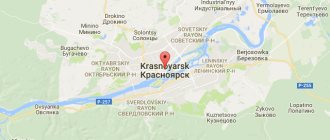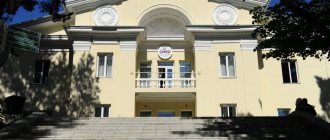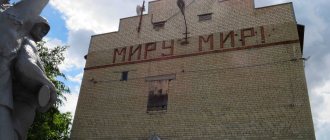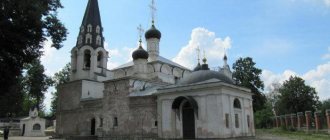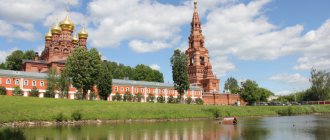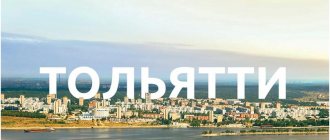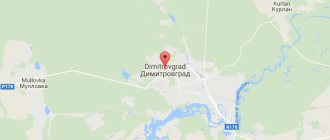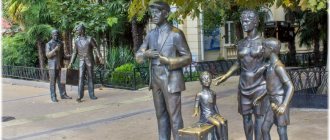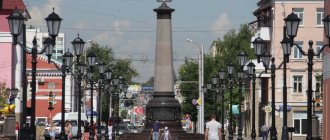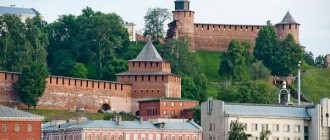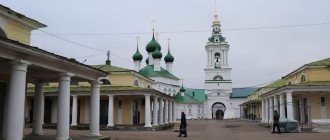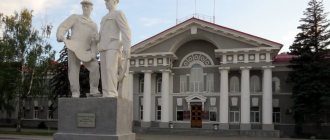TRUBCHEVSK
TRUBCHEVSK, a city in Russia, in the Bryansk region, the center of the Trubchevsky district. Us. 13.6 thousand people (2019). Located on the river. Desna, 53 km from the railway. Art. Suzemka.
Story
The city arose in the 2nd half. 12th century based on a settlement from the 9th–11th centuries. In 1164–1500 the center of the Trubchevsky princedom. In the 2nd half. 12th century expanded, adjacent to Detinets (40×40 m) was a triangular round town (800×500 m), where a stone temple was erected. It was first mentioned in the Tale of Bygone Years in 1185 as Trubechsk. Among the finds is a treasure trove of ancient Russian jewelry. time (late 12th – early 13th centuries; including silver with niello, cross made using cloisonné enamel technique).
Probably from the 1370s. within the Grand Duchy of Lithuania. In 1500, during the Rus.-Litov. wars of 1500–1503, the Trubchev princes (see Trubetskoys) went into the service of the great. book Moscow Ivan III Vasilyevich with his possessions, T. became part of Rus. state (secured by the Moscow Truce of 1503). During the Livonian War of 1558–83, he was ravaged by a detachment of the prince. M. A. Vishnevetsky in 1581. In the 1580s. new fortifications were erected. During the Time of Troubles in 1609, False Dmitry II granted it to the Sandomierz governor J. Mnishek. According to the Deulin truce of 1618, it went to the Polish-Lithuanian Commonwealth. On Dec. 1632 occupied by Russian. troops during the Russian-Polish wars of 1632–34, according to the Treaty of Polyanovsky in 1634 it remained part of the Polish-Lithuanian Commonwealth. During border surveying, additional Protocol dated October 18 (28), 1644, the city was transferred to Rus. state-woo In 1659 new wood-earth fortifications were built. From 1660 belonged to the prince. A. N. Trubetskoy. From the end 17 – beginning 18th centuries Industry developed in T. and the district (iron-making, glass factories, in the 2nd half of the 18th century - distilleries, etc.). District city of the Kyiv province (1708–19), Sevsk province of the Kyiv (1719–27) and Belgorod (1727–78) provinces, Oryol province (1778–1920; until 1796 - Oryol governorship). During the Patriotic War of 1812 it was a base for the procurement of provisions for the Russians. army.
Sov. power was established on January 2(15), 1918. County town (1920–24) and volost center of Pochepsky district. (1924–29) Bryansk province. Regional center of the Bryansk region. Western region (1929–30), Western region. (1930–37), Oryol region (1937–44). In Vel. Otech. the war to the west of T. 29.8–5.9.1941 one of the largest oncoming tank battles of the initial stage of the war took place (up to 600 tanks and armored vehicles on both sides). Germany is occupied. troops on October 9, 1941, was heavily destroyed. Liberated by Soviet troops on September 18, 1943 during the Bryansk offensive operation. Regional center of the Bryansk region (1944–63, since 1964).
Architecture. Cultural centers
Trubchevsk. View of the city. Photo by I. P. Shpilenok
It developed according to the regular plans of 1780 and 1808. On Cathedral Hill there is the Cathedral of the Life-Giving Trinity in the late Baroque style (1784–92, on the foundations of the cathedral of the last third of the 12th century and the basement of the cathedral of 1503–20, where the vaulted white stone tomb of the Trubetskoy princes of the 16th–17th centuries has been preserved .) with classicism. bell tower (1824); ruins c. Transfiguration of the Savior (1690–93, on the foundations of the temple 1640–49; bell tower, 1760; refectory, mid-19th century) and c. Intercession of the Blessed Virgin Mary (1787–96, reconstruction, 2nd half of the 19th century); Kamenitsa (18th century). There are many in the city center. civil monuments architecture of the 19th century, including the building of an orphanage (1878). To the mountains cemeteries - the Church of the Presentation of the Lord (1811) and the Prophet Elijah in the Russian style (1846–48, rebuilt in 1890–96). Monument to the 1000th anniversary of T. with the figure of Boyan (1975; sculptor A. I. Kobylinets). Museum and Planetarium (1919, current name and status since 2005), Lit. museum (2015). A jeweler's treasure from the 2nd–3rd quarter was found in T. 7th century - one of the richest circles of the Martynovsky treasure.
Farm
Production of products for the needs of the defense industry (Monolit plant, aircraft gun installations and containers, automation units, pre-flight diagnostic systems for on-board equipment); food industry enterprises (Desnyansky food processing plant, Trubchevskkhleb).
Neighborhood
On the outskirts of T., in the village. Gorodtsy, – House of Peasant Life (opened in 2008). South of T., near the village. Kvetun, - the remains of one of the centers of the northerners (9th–10th centuries) and other Russian. multi-ethnic pre-urban center (late 10th–12th centuries; female burials of 5 Eastern Slavic tribes, Balts and Finno-Ugrians were recorded), which in the 12th–13th centuries probably turned into a country princely residence. An ancient settlement, a settlement, and numerous settlements were studied. mounds (including partial cremation in a semi-ground “chamber” with belt overlays, turn of the 10th–11th centuries); on the site there are plinths from the church or princely mansions; in the village there are traces of iron production and lime production; etc. On the territory of the settlement there are the remains of the Spassky Cholsky men's monastery. (founded in the 16th century, closed in 1923), including Vvedenskaya Church. (1733) with a refectory (1731–41), a bell tower and part of the fence (late 18th – early 19th centuries). In the vicinity of T. there is a Baroque church. The Descent of the Holy Spirit in the village. Selets (1781), wooden. c. Dormition of the Blessed Virgin Mary in the village. Radutino (1870).
Historical and memorable places of the Bryansk region
The city of Trubchevsk is one of the oldest cities in the Russian state. It is located on the right bank of the Desna River, 94 km. From Bryansk. Based on archaeological excavations, scientists believe that it was founded in 975. 10 km. From Trubchevsk, in the village of Kvetun, a fortification from the 10th-13th centuries has been preserved. - the place of origin of the city.
The name Trubchevsk contains the root of the word “pipe”. In ancient times, a pipe was the name given to a channel, a river bed, and there is an assumption that the name arose from the location of the settlement on the Trubezh River. The city was first mentioned in the chronicle in 1164, and in 1185 in the “Tale of Igor’s Campaign” we find a story that the Trubchev-Kursk prince Vsevolod and his brother Igor participated in a campaign against the Polovtsians. The Trubchev squad took part in the battle on the Kalka River in 1223.
Since the conquest of Rus' by the Mongol-Tatars, Trubchevsk has disappeared from the pages of chronicles and appears only at the end of the third quarter of the 14th century, when it was ruled by the son of the Grand Duke of Lithuania, Olgerd Dmitry. It was he who took part in the Battle of Kulikovo in 1380 and from him came the family of the Trubetskoy princes, whose graves are preserved in the Trinity Cathedral . In 1503, under a treaty, Trubchevsk was transferred by Lithuania to the Moscow state.
The frequent wars between Moscow and Poland brought a lot of grief to the region. Strife, and then war, led to the fact that in the period from 1618 to 1644. Trubchevsk came into the possession of the Polish state. Due to these circumstances, and after his return, the city has always been an important strategic point of the Russian state. By order of Peter I, it was included in a powerful defensive abatis “..from Smolensk to Bryansk...”.
By the end of the 17th century, the city entered the orbit of the all-Russian market. The fair of the Bryansk Svensky Monastery helped develop trade. The Trumpets traded mainly in hemp and hemp oil. Moscow merchants kept potash factories here, and sold their products to England and Holland. Widespread trade developed with Prussia and France - goods were floated along the Desna and Dnieper rivers. Trubchevsk was famous for its gardening, in memory of which pears are placed on its coat of arms. From 1778 to 1918 Trubchevsk was the district center of the Oryol province.
As a result of the reforms of the 60s. 19th century The city began to develop noticeably: by the end of the century, 39 hemp factories operated here, 100 shops traded briskly, 65 merchants lived, three week-long fairs were vigorously held, about 600 people were engaged in crafts.
The years of the 1917 revolution and the civil war led to a threefold reduction in the city's population (from 7,000 thousand). Only during the NEP years did the region's economy begin to recover.
The occupation of the city by Nazi troops during the Great Patriotic War lasted from August 28, 1941 to September 18, 1943. A bright page of history for us is the actions of Trubchev’s partisans and underground fighters behind enemy lines. In 1944, Trubchevsk became the regional center of the Bryansk region.
In modern Trubchevsk there is a vegetable drying plant, a butter and cheese making plant, a hemp plant, and a knitting factory. On the territory of the city park there is the Yukhnovskoe fortification of the 5th-1st centuries. BC, Trinity Cathedral, Intercession and Transfiguration churches. The residential buildings of the 18th and 19th centuries are well preserved. The pride of the local history museum is the Anta treasure from the 6th-7th centuries. The city is proud of its sons - the traveler to India and China, merchant N. Chelobitchikov, teacher A.S. Pushkin, philosopher A. Galich, commander I. Petrov. According to 1992 data, the city's population is 16.4 thousand people.
- Afonkina (Ivanyushina), A.M. From the history of churches and parishes of the Trubchevsky district / A.M. Ivanyushina // Chronicle of the Trubchevsky region: Mater. I-III local history readings. - Bryansk. - 2009. - P. 75 - 84.
- Archaeological map of Russia: Bryansk region / Author - comp. A.V. Kashkin. - M., 1993. - P. 240-254.
- Babushkin A.N. Bryansk region: Geographer. and ist.-econ. feature article. — Bryansk: Bryan. worker, 1958. - P. 334-338.
- Blokhin S.A. On the geographical and historical description of the city of Trubchevsk according to the documents of the Trubchevsky city magistrate of 1779 // Proceedings of the Oryol Scientific Archival Commission. - 1890. - Issue. 3. - pp. 25-33.
- Bryansk region: guide to places of interest / ed. I.V. Polyakova; cons. EAT. Zubova, V.P. Alekseev, S.A. Nikulina, K.V. Sychev. - Bryansk, 2006. - pp. 33-34.
- Gorodkov V. Architectural images of the Bryansk region. — Tula.: Priok. book publishing house, 1990. - pp. 103-118.
- Urban settlements in the Russian Empire..- St. Petersburg: Type. K. Wolf, 1863.- T. 3.- P. 574-578.
- Zyablovsky E. Land description of the Russian Empire for all states. - SPb.: Type. F. Drechsler, 1810. - Part V. - pp. 216-224.
- Historical description of churches and parishes of Trubchevsky district / [under the general. ed. O.R. Vyazmitina]. – White Banks, 2008. – 63 p.
- Kondrat I.F. Today and tomorrow of Trubchevsk // Bryansk local historian. - Bryansk, 1976. - Issue. VIII. — P. 94-101.
- Krashennikov V. A look through the centuries. — Tula: Priok. book publishing house, 1990. - pp. 24-27.
- Levenok V.P. Formation of an ancient Russian city // Bryansk local historian. - Bryansk, 1976. - Issue. VIII. — P. 15-31.
- Padin V.A. Memorable places of the Trubchevsky district. - Bryansk, 1969. - 102 p.
- Padin V. Trubchevsk. — Tula: Priok. book publishing house, 1966. - 235 p.
- Padin V. Trubchevsk. — 2nd ed., add. and corr. — Tula: Priok. book publishing house, 1975. - 235 p.
- Padin V.A. Trubchevsky attractions: Archeology, history, ethnography of the region. - Bryansk, 1995. - 130 p.
- Complete geographical description of our Fatherland / Under. Ed. V.P. Semenov. - St. Petersburg, 1902. - T. 2. - Central Russian Chernozem Region. — P. 555-556.
- Pyasetsky G. History of the Oryol diocese. - Orel, 1899. - P. 70, 71, 157-159.
- Collection of architectural monuments and monumental art of Russia: Bryansk region. - M.: Nauka, 1996. - P. 539-567.
- Tikhonov N. Ten centuries of Trubchevsk. — Tula: Priok. book publishing house, 1980. - 284 p.
- Tikhonov N.G. Glorious knights of Trubchevsk. - Bryansk: Grani, 1996. - 63 p.
- Trubchevsk // Cities of Russia: Encycl. - M., 1994. - P. 477.
- Trubchevsk // Pages from the Bryansk Chronicle: Special. issue "Agitator's Notebook" - Bryansk, 1968. - P. 240-245.
- Trubchevsk //Encyclopedic Dictionary. - Reprint. reproduction ed. F. Brockhaus - I.A. Efron 1890 - M., 1993. - T. 66. - P. 927.
- Tsapenko M. Bryansk land. - M.: Art, 1972. - P. 105-113.
- Shulgin A.N. The past of the Oryol region: Essay. — Eagle: Type. Governor. Board, 1903. - 109 p.
- Kuzkin S. The main house in the city // Trubchevskaya Land. - 2002. - September 25. (No. 77).
- Padin V. Merchants loved Trubchevsk // Trubchevskaya Land. - 2001. - November 21.
- Padin V. Streets of Trubchevsk // Trubchevskaya Land. - 1995. - November 4.
- Rudenkov G.N. The Golden Age of Trubchevsk // Trubchevskaya Land. - 1999. - April 24, 29, May 5, 12, 15, 19, 22, 26, 29, June 2.
- Sokolov Ya. Trubchevsk//Bryan. worker. - 1998. - February 6. — P. 17
Trubchevsk
(Bryansk region)
OKATO code:
15256501
Founded:
975
City from:
975 City of district subordination (Trubchevsky district, Bryansk region)
Center:
Trubchevsky district
Telephone code (reference phone)
| 48352***** | 24-00-8 |
Deviation from Moscow time, hours:
0
Geographic latitude:
52°35′
Geographic longitude:
33°46′
Altitude above sea level, meters:
170 Sunrise and sunset times of the Sun and Moon in the city of Trubchevsk
